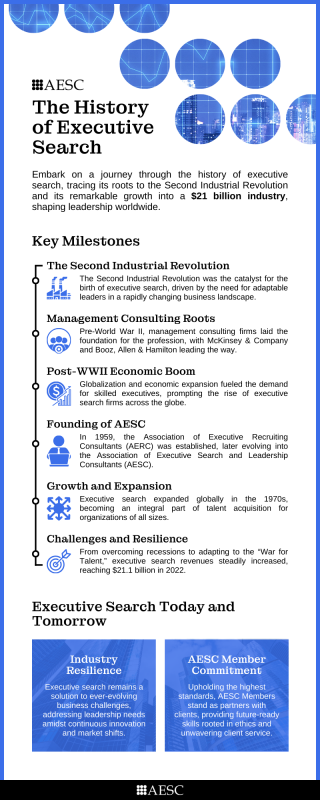Insights
The History of Executive Search
 The Second Industrial Revolution set forth a chain of events that led to the birth of the executive search profession. Since then, the executive search profession has paralleled major trends in business, organizations and socio-economic development. Today, the profession generates over $21 billion and places the top leaders worldwide.
The Second Industrial Revolution set forth a chain of events that led to the birth of the executive search profession. Since then, the executive search profession has paralleled major trends in business, organizations and socio-economic development. Today, the profession generates over $21 billion and places the top leaders worldwide.
So, how did the Second Industrial Revolution lead to the origination of the profession? And how has it grown into the incredible profession it is today? Journey with us as we examine the history of executive search and how it’s evolved in concert with the state of the world.
The Second Industrial Revolution: A Catalyst for a New Profession
During the Second Industrial Revolution (1870-1914), businesses – especially those in the United States and Europe – changed dramatically. Innovations contributed to a period of accelerating industrialization: the expansion of rail and telegraph lines improved access to markets and lowered costs for the movement of parts and finished goods; new, efficient methods of production made the process of turning raw material into a finished product faster and more efficient. These dramatic shifts created a need for leaders who could adapt to the changing business landscape and the demands of scale.
Management consulting firms like McKinsey & Company, and Booz, Allen & Hamilton stepped in to fulfill this need by recruiting executives who could implement a recommended strategy to solve a client’s problem. In 1914, Edwin G. Booz said, “Often the best solution to a management problem is the right person.”
And thus, executive search was born.
 From Management Consulting to Executive Search
From Management Consulting to Executive Search
Before World War II and through the 1940s, several early retained executive search firms were founded as offshoots of management consulting, four by McKinsey & Company and Booz, Allen & Hamilton alumni and two by alumni of major accounting firms. McKinsey and Booz Allen also operated their own executive recruiting functions. (McKinsey exited the field in 1951 when Ward Howell left to start his own firm, while Booz Allen continued searches for clients until 1980.)
The search consultants who came out of these firms applied the tenets of management consulting to their endeavors from the start, thus laying the foundation for the legitimacy of retained executive search as a consulting discipline.
Economic Boom & Globalization: The Rise of Executive Search
The end of WWII led to a wave of economic expansion and globalization that reached across North America, Western Europe, Japan, Australia and the newly industrialized economies of Asia: South Korea, Taiwan, Singapore and Hong Kong. This was fueled largely by the growth of international trade.
Businesses jumped on the opportunity to expand their reach. Organizations also moved away from the tradition of developing and promoting managers from within. Business leaders more frequently sought skilled, experienced executives from outside their organizations.
As the demand for top talent grew, so did the need for retained executive search. Executive search firms began popping up around the globe, ready to find and place skilled leaders in C-level, executive and board positions.
The Founding of AESC
With increasing numbers of people entering the profession, some of the leading firms knew they had to set themselves apart from the burgeoning field. In the fall of 1958, several leaders of the most prestigious executive search firms gathered to “take steps to raise standards of the emerging professional field of executive recruitment by establishing a non-profit membership association in which only competent and ethical executive recruiting firms could qualify for membership.”
The Association of Executive Recruiting Consultants (AERC) was incorporated on December 18, 1959. It was established for two purposes: to create a professional association for the most competent and reputable search firms, and to provide clients and prospective clients with a means to differentiate qualified and ethical practitioners. The association would become a hallmark of quality and integrity.
In the years ahead, AERC concentrated its efforts on maintaining and publicizing the Association’s high standards and developing its legislative influence to protect the profession from unnecessary regulatory interference.
In 1982, AERC changed its name from the Association of Executive Recruiting Consultants to the Association of Executive Search Consultants to better reflect the organization’s members. In recognition of the expanding role of member firms, AESC embraced leadership consulting in its identity and, in 2014, changed the organization's name to the Association of Executive Search and Leadership Consultants.
The Growth & Expansion of Executive Search
As client organizations grew in new markets around the world, executive search firms expanded to meet their needs. From 1970 through the 1990s, executive search spread steadily, first within Europe and then into Latin America and Asia.
As clients saw the effectiveness of employing a dedicated consulting service to help them locate and hire executive talent, they commissioned searches more broadly within their management ranks. Companies that had filled positions through “old boy” networks saw that engaging search firms might help them attain a competitive edge and inject new thinking and innovation into their cultures.
This expanded demand set the pace for the growth of the executive search firms that populate the industry today. The business flourished despite setbacks during recessions, and by the late 1980s, even nonprofit organizations, higher education institutions and government agencies started commissioning searches to fill key positions.
From 1978 to the early 2000s, executive search revenues steadily increased. The early 2000s saw demographic shifts, surging demand for emerging markets and a “War for Talent,” which led to a nearly 120% increase in global demand for executive search services from 2004 to 2008.
The profession experienced steady growth, again, from 2012 to 2019, reaching $16 billion. 2020 saw a bit of a dip due to the global pandemic, but the profession rebounded in 2021 with $19.9 billion in revenue. Then, growth continued in 2022 to reach $21.1 billion.
Tackling Client Challenges Now & Into the Future
Since its inception, executive search has remained a solution to the changing business environment and the leadership challenges organizations face as a result.
Due to continuous innovation, evolving technology, advances in science and engineering, shifts in economic forces and the expansion of markets, there is always a need for top executives with the skills and experience to build on the opportunities of the moment.
Executive search firms – especially AESC Members who ascribe to the highest standards - partner with their clients to address their most urgent business needs with future-ready skills rooted in a commitment to ethics and client service.
And they will continue to do so as organizations face new challenges in the future.
Subscribe to AESC SmartBrief for the latest in executive search and leadership consulting.